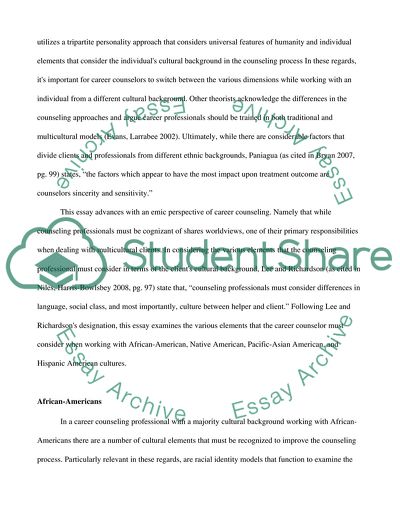CHECK THESE SAMPLES OF Multicultural Career Counseling
The writer of an essay "Personal counseling Approach" points out that any task involving the human constituent-from plotting a war to planning for a career-involves a certain degree of ambiguity, because human behaviour is often unpredictable.... Personal counseling Approach Human beings do not fit neatly into pigeonholes of theory and practice.... In fact, the counseling profession depends upon it.... Having been raised in a liberal, open-minded family, I aim to take a tolerant, gentle, but straightforward approach to counseling....
2 Pages
(500 words)
Essay
The issue of multicultural supervision has become of interest in the academic circles in the recent years.... Of late, it has started to permeate literature in the world which means there has been increased need for supervisors to have the necessary training in multicultural supervision to be effective in their work....
4 Pages
(1000 words)
Essay
Consider the nature of your cultural experience, describe five strengths you will bring to multicultural counseling?... Considering the nature of my cultural experience, five strengths I will bring to multicultural counseling will be my openness, my honesty, my sense of respect for other cultures, my perceptiveness, and my creativeness.... Five knowledge goals that, if met, would help me develop as a culturally competent counselor are the following: culture-specific knowledge, cross-cultural counseling techniques, broad knowledge about various cultures, behavioral psychology, and common culture-specific issues....
2 Pages
(500 words)
Essay
counseling methods should reflect this and program methods to help cultural assimilation without sacrificing appreciation for cultural heritage (Vontress et al, 19999).... There are many taboos developed form these beliefs that may deter counseling particularly those related to issues such as gender, sexuality, cultural and national identity such as standards of beauty, family loyalty, machismo and the concept of being a Latino.... The respondents of the interview have all acknowledged these beliefs and have expressed their consensus that though many of these beliefs are changing, the change is more because of simply coping rather than a cultural movement to distance from beliefs that do not encourage counseling or the referring “family matters” outside the family....
2 Pages
(500 words)
Essay
Having a sexual relationship with a ent who comes for career counseling or any other counseling is a way to cause harm to the client which is a violation of A.... I believe this to be important because counselors must understand the counseling relationship.... This means as an example, that a career professional does not engage in mental health counseling because it is not within the scope of practice.... The standards that I chose to compare with the NCDA standards re the American counseling Association (ACA) standards....
3 Pages
(750 words)
Essay
career counseling with visibly recognizable racial and ethnic minority groups in Capuzzi, D.... career counseling with gay, lesbian, bisexual and transgender clients in Capuzzi, D.... (2006) career counseling: Foundations, perspectives and applications.... The counselor must understand that coming out is an added feature that must be taken into consideration when counseling GLBT individuals.... Career counseling: Foundations, perspectives and applications....
4 Pages
(1000 words)
Essay
None has a comprehensive outlook about the genuine needs of the students in a multicultural, multi-ethnic society that suffered from the bane of racism for more than two centuries.... This essay discusses the Goals of Education.... Benjamin Franklin highlighted the importance of teaching history and “in 1749 he proposed that Pennsylvania establish a public school that should, he said, place as much emphasis on physical as on intellectual fitness....
5 Pages
(1250 words)
Essay
One of the notable ways of reducing employee turnover is by matching employee's personality traits to the job description during the… People are also seeking to find the occupation that most suits their personality so as to find fulfillment in what they do.
Many theories have been developed by psychology researchers to explain the connection that exist Of the available theories, two theories have stood out over the years; The Holland's code and the Big 5 career theories....
5 Pages
(1250 words)
Research Paper


